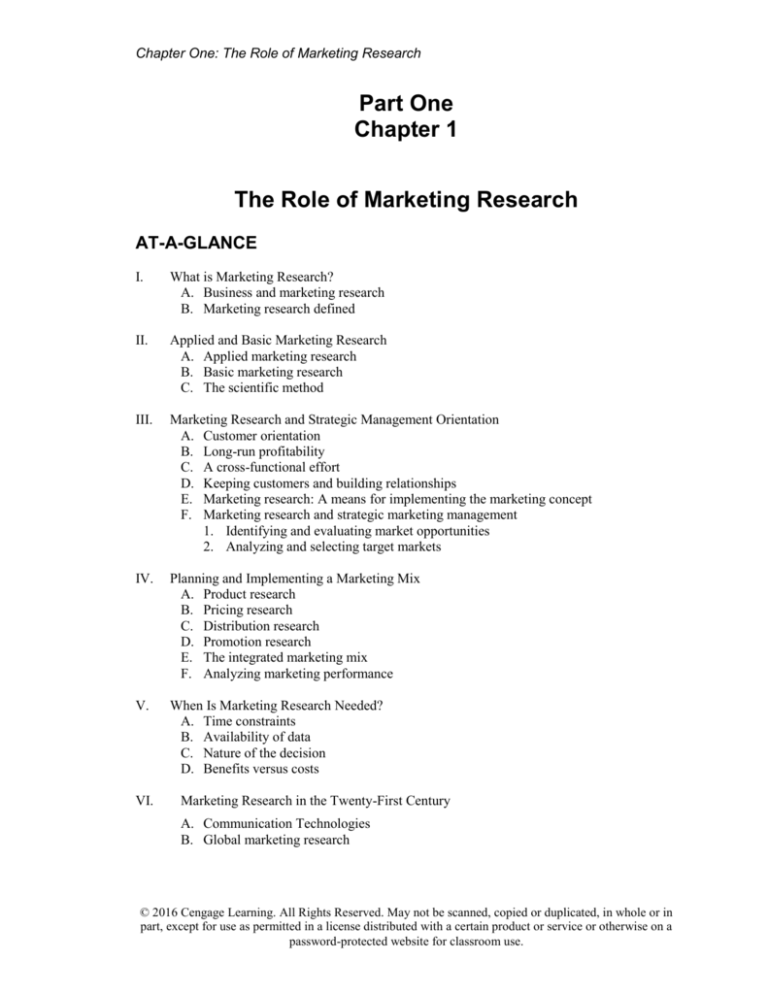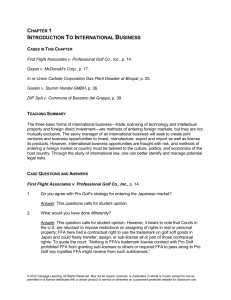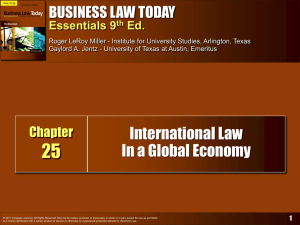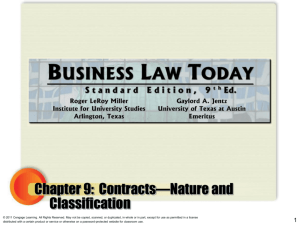
Chapter One: The Role of Marketing Research
Part One
Chapter 1
The Role of Marketing Research
AT-A-GLANCE
I.
What is Marketing Research?
A. Business and marketing research
B. Marketing research defined
II.
Applied and Basic Marketing Research
A. Applied marketing research
B. Basic marketing research
C. The scientific method
III.
Marketing Research and Strategic Management Orientation
A. Customer orientation
B. Long-run profitability
C. A cross-functional effort
D. Keeping customers and building relationships
E. Marketing research: A means for implementing the marketing concept
F. Marketing research and strategic marketing management
1. Identifying and evaluating market opportunities
2. Analyzing and selecting target markets
IV.
Planning and Implementing a Marketing Mix
A. Product research
B. Pricing research
C. Distribution research
D. Promotion research
E. The integrated marketing mix
F. Analyzing marketing performance
V.
When Is Marketing Research Needed?
A. Time constraints
B. Availability of data
C. Nature of the decision
D. Benefits versus costs
VI.
Marketing Research in the Twenty-First Century
A. Communication Technologies
B. Global marketing research
© 2016 Cengage Learning. All Rights Reserved. May not be scanned, copied or duplicated, in whole or in
part, except for use as permitted in a license distributed with a certain product or service or otherwise on a
password-protected website for classroom use.
Chapter One: The Role of Marketing Research
LEARNING OUTCOMES
1.
2.
3.
4.
5.
6.
Know what marketing research is and what it does for business.
Understand the difference between basic and applied marketing research.
Understand how the role of marketing research changes with the orientation of the firm.
Be able to integrate marketing research results into the strategic planning process.
Know when marketing research should and should not be conducted.
Appreciate the way that technology and internationalization are changing marketing research.
CHAPTER VIGNETTE: “Samapple!!”
The technology sector is perhaps one of the fastest moving areas of today’s consumer market. As
technology continues to change and grow, firms must be aware of consumers’ desires in order to
compete effectively. Apple, once America’s favorite technology brand, became complacent,
neglecting the critical role that market research plays before the development of new products. As
a result, Apple has slipped from first place to fifth place, with other firms rising to the top,
particularly Samsung. This vignette clearly illustrates the importance of agile marketing research
in the technology sector.
SURVEY THIS!
This feature allows students to better understand the researcher’s job in determining what
information is needed so that data can be analyzed and become an intelligent source of
information. This first interaction with the “Survey This!” feature is for students to play the role
of respondent and complete the survey by going to the URL provided by your instructor. Answers
are anonymously stored in the database along with those of other students using this book around
the world. Once the survey is completed, students can visit the course website and obtain a copy
of the questions.
RESEARCH SNAPSHOT
Care for Some Horns and Halos
In marketing parlance, a halo is an effect that indicates a consumer has a positive perception
of a product, whereas a horn indicates a consumer’s negative perception of a product. These
effects have a particularly strong influence over consumers’ beliefs about food and nutrition.
Marketing research has demonstrated that some of these beliefs can be mitigated over time.
A Hog Means Family
Harley-Davidson has worked hard to establish long term relationships with its customers by
utilizing marketing research. The firm has been particularly skilled in using social media
data-mining to assess the interests of its American customers.
When it came time to branch out overseas, Harley-Davidson engaged in marketing research
to assess the preferences of Indian consumers, who have long preferred scooters to larger
motorcycles. This research allow the company to expand its customer base.
© 2016 Cengage Learning. All Rights Reserved. May not be scanned, copied or duplicated, in whole or in
part, except for use as permitted in a license distributed with a certain product or service or otherwise on a
password-protected website for classroom use.
Chapter One: The Role of Marketing Research
Watching What?
The changing landscape of technology has significantly altered the way Americans consume
television programming. This shift has led Nielsen, once the foremost research firms for
tracking television viewing habits, to make errors in their estimates of viewership. This
snapshot illustrates how important it is to maintain accurate data collection techniques,
especially in the face of a changing technological landscape.
TIPS OF THE TRADE
Throughout the text, a Tips of the Trade section is provided to give hints for using and doing
marketing research. Here is a summary of this chapter’s tips:
Customers and employees are valuable sources for input.
Business problems ultimately boil down to information problems.
Good marketing research is as rigorous as good research in other fields.
Research plays a role before, during, and after key marketing decisions.
Research that costs more than it can ever return should not be conducted.
Researchers must stay in touch with changes in media technology.
OUTLINE
I.
WHAT IS MARKETING RESEARCH?
A. Business and Marketing Research
1. Companies need to produce benefits that people want to buy, and successful
companies must understand the bundle of benefits consumers need. Answering
several key questions help provide this understanding:
a. What do we sell? – This includes not only the benefits that are easily seen,
but also the more emotional benefits.
b. How do consumers view our company? – All too often, companies define
themselves too narrowly based only on the physical product they sell. Who
will the customer do business with if they do not choose your company?
c. What does our company/product mean? – What knowledge do people have
of the company and its products?
d. What do consumers desire? – How can the company make the lives of its
customers better, and how can it do this in a way that is not easily duplicated
by another firm?
2. Answering these questions requires information, and marketing research’s
function is supplying that information. With useful information, decisions can be
made with less risk.
3. The emphasis of marketing research is to shift decision makers from intuitive
information gathering to systematic and objective investigating.
B. Marketing Research Defined
1. Marketing research is the application of the scientific method in searching for
the truth about marketing phenomena.
2. The process includes:
a. Idea and theory development
b. Problem definition
© 2016 Cengage Learning. All Rights Reserved. May not be scanned, copied or duplicated, in whole or in
part, except for use as permitted in a license distributed with a certain product or service or otherwise on a
password-protected website for classroom use.
Chapter One: The Role of Marketing Research
c. Information gathering
d. Analyzing data
e. Communicating the findings and their implications
3. This definition suggests that marketing research:
a. information is not intuitive or haphazardly gathered
b. is accurate and objective, using the scientific method
c. is relevant to all aspects of the marketing mix
d. is limited by one’s definition of marketing
4. Marketing research can be used for any aspect of the marketing mix.
5. Marketing research can be used by all types of organizations that engage in some
form of marketing activity.
II.
APPLIED AND BASIC MARKETING RESEARCH
A. Applied Marketing Research
1. Applied marketing research is conducted to address a specific marketing
decision for a specific firm or organization.
B. Basic Marketing Research
1. Basic marketing research is conducted without a specific decision in mind and
it usually does not address the needs of a specific organization.
2. It attempts to expand the limits of marketing knowledge in general, and as such it
is not aimed at solving a particular pragmatic problem.
C. The two types of research are not completely independent.
1. Some reserve the term marketing research to refer to basic research and the term
market research to capture applied research addressing the needs of a firm within
a particular market.
2. However, there are very few aspects of research that apply to only basic or only
applied research.
3. This text uses the term marketing research more generally to refer to either type
of research.
D. The Scientific Method
1. All marketing research, whether basic or applied, involves the scientific method.
2. The scientific method is the way researchers go about using knowledge and
evidence to reach objective conclusions about the real world.
3. The method involves developing hypotheses and testing them against empirical
evidence (facts from observation or experimentation). From these results, new
knowledge is acquired.
4. Its use in basic research leads to inferences and conclusions about phenomena
and leads to the establishment of general laws.
5. Its use in applied research ensures objectivity in gathering facts and testing
creative ideas for alternative marketing strategies.
III.
MARKETING RESEARCH AND STRATEGIC MANAGEMENT ORIENTATION
A. In all of business strategy, there are only a few business orientations:
1. Product-oriented – the firm prioritizes decision making in a way that
emphasizes technical superiority in the product. Research is not a priority.
2. Production-oriented – the firm prioritizes efficiency and effectiveness of the
production processes in making decisions (i.e., to drive costs down). Research is
not a priority.
© 2016 Cengage Learning. All Rights Reserved. May not be scanned, copied or duplicated, in whole or in
part, except for use as permitted in a license distributed with a certain product or service or otherwise on a
password-protected website for classroom use.
Chapter One: The Role of Marketing Research
B.
C.
D.
E.
F.
G.
3. Marketing-oriented – the firm follows the marketing concept, which focuses
on how the firm provides value to customers more than on the physical product
or production process.
Developing a marketing orientation calls on management to:
1. Be customer-oriented.
2. Emphasize long-run profitability rather than short-term profits or sales volume.
3. Adopt a cross-functional perspective.
a. A stakeholder orientation recognizes that multiple parties are affected by a
firm’s decisions.
Customer Orientation
1. The consumer should be the primary focus of attention.
2. The firm creates products and services with consumers’ needs in mind.
3. The creation of value for consumers is the justification for a firm’s existence.
4. Marketing research addressing consumer desires, beliefs, and attitudes is
essential.
5. Although technology firms are usually thought of as product-oriented, that view
is changing to a customer orientation.
Long-Run Profitability
1. Implicit in the marketing concept is the assumption of the continuity of the firm.
2. One way to ensure long-run profitability is to utilize online sentiment analysis,
which allows researchers to use data to indicate the total positive or negative
mentions of a brand on the Internet.
3. Another aspect of long-run profitability argues against profitless volume or sales
volume for the sake of volume alone.
A Cross-Functional Effort
1. Marketing personnel do not work in a vacuum – actions of people in other areas
(i.e., production, credit, and R&D) may affect marketing efforts, and the work of
marketers will affect activities in other departments.
2. Problems occur when the marketing department views focusing on consumer
needs as its sole responsibility.
3. It is vital that management conducts marketing research, that researchers produce
valid and reliable results, and that those results be communicated to decision
makers.
Keeping Customers and Building Relationships
1. Effective marketers work to build long-term relationships with their customers.
2. Relationship marketing communicates the idea that a major goal of marketing
is to build long-term relationships with customers contributing to a firm’s
success.
3. A sale is not the end of a process; it is the start of the organization’s relationship
with a customer.
4. Total quality management is a business philosophy that has much in common
with the marketing concept.
a. A company that employs a total quality strategy must evaluate itself through
the eyes of the customer.
5. The notion that quality improvement is every employee’s job must be integrated
throughout the organization so that marketing and production will be in harmony.
Marketing Research: A Means for Implementing the Marketing Concept
1. Marketing research can also help prevent commercialization of products that are
not consumer-oriented.
2. By improving efficiency, research also facilitates profitability.
© 2016 Cengage Learning. All Rights Reserved. May not be scanned, copied or duplicated, in whole or in
part, except for use as permitted in a license distributed with a certain product or service or otherwise on a
password-protected website for classroom use.
Chapter One: The Role of Marketing Research
3. Analysis of data may also be a form of marketing research that can increase
efficiency.
H. Marketing Research and Strategic Marketing Management
1. The prime managerial value of marketing research is that it reduces uncertainty
by providing information that facilitates decision making about marketing
strategies and the tactics used to achieve an organization’s strategic goals.
2. Developing and implementing a marketing strategy involves four stages:
a. Identifying and evaluating market opportunities
b. Analyzing market segments and selecting target markets
c. Planning and implementing a marketing mix that will provide value to
customers and meet organizational objectives
d. Analyzing firm performance
3. Identifying and Evaluating Opportunities
a. Marketing research can be used to monitor the competitive environment for
signals indicating business opportunities or problems.
b. Market opportunities may be evaluated using many performance criteria.
c. Research may be used to develop objective forecasts of demand or changing
environments.
4. Analyzing and Selecting Target Markets
a. Marketing research is a major source of information for determining which
characteristics of market segments distinguish them from the overall market.
b. Geo-demographics refers to information describing the demographic profile
of consumers in a particular geographic region.
IV.
PLANNING AND IMPLEMENTING A MARKETING MIX
A. Marketing research may be needed to support specific decisions about any aspect of
the marketing mix.
B. It is essential that an overall research plan involve all elements of marketing strategy.
C. Product Research
1. Takes many forms:
a. Concept testing—exposes potential customers to a new product idea to judge
the acceptance and feasibility of the concept.
b. Product testing—reveals a product prototype’s strengths and weaknesses or
determines whether a finished product performs better than competing brands
or according to expectations.
c. Brand-name evaluation studies—investigate whether a name is appropriate
for a product.
d. Packaging testing—assesses size, color, shape, ease of use, and other
attributes of a package.
D. Pricing Research
1. Many test markets address the question of how consumers will respond to a
product offering two different prices.
2. Pricing involves finding the amount of monetary sacrifice that best represents
the value customers perceive in a product after considering various market
constraints.
3. Pricing research addresses consumer quality perceptions by its very nature.
4. Research has shown that prices can actually be too low.
© 2016 Cengage Learning. All Rights Reserved. May not be scanned, copied or duplicated, in whole or in
part, except for use as permitted in a license distributed with a certain product or service or otherwise on a
password-protected website for classroom use.
Chapter One: The Role of Marketing Research
E. Distribution Research
1. A marketing channel (a.k.a. supply chain) is a network of interdependent
institutions that perform the logistics necessary for consumption to occur.
2. Distribution research:
a. Is typified by studies aimed at selecting retail sites or warehouse locations.
b. Often is needed to gain knowledge about retailers’ and wholesalers’
operations and to learn their reactions to a manufacturer’s marketing policies.
c. May also be used to examine the effect of just-in-time ordering systems or
exclusive distribution on product quality.
F. Promotion Research
1. Promotion is the communication function of the firm responsible for informing
and persuading buyers.
2. Promotion research investigates the effectiveness of advertising, premiums,
coupons, sampling, discounts, public relations and other sales promotions.
3. Media research helps businesses make decisions about whether television,
newspaper, magazines, or other media alternatives are best suited to convey the
intended message.
G. The Integrated Marketing Mix
1. Integrated marketing communication means that all promotional efforts
should be coordinated to communicate a consistent image.
2. Likewise, the elements of the marketing mix itself must work together.
3. From a research standpoint, the integrated marketing mix means that research
studies often investigate effects of various combinations of marketing mix
elements on important outcomes like sales and image.
H. Analyzing Marketing Performance
1. Marketing research may be conducted to obtain feedback for evaluation and
control of marketing programs.
2. This is especially important for successful total value management, which
attempts to manage the entire process by which a consumer receives benefits
from a company.
3. Performance-monitoring research refers to research that regularly, sometimes
routinely, provides feedback for evaluation and control of marketing activity.
a. Market-share analysis and sales analysis are the most common, but not the
only, forms.
b. Marketing metrics refer to quantitative ways of monitoring and measuring
marketing performance, and they allow the firm to assess the ROI associated
with marketing activities.
V.
WHEN IS MARKETING RESEARCH NEEDED?
A. The determination of the need for marketing research centers on:
1. Time constraints.
2. Availability of data.
3. The nature of the decision.
4. The value of the research information in relation to costs.
B. Time Constraints
1. Systematic research takes time.
2. Sometimes the urgency of a situation precludes the use of research.
C. Availability of Data
1. When managers lack adequate information, research must be considered.
2. Data need to be collected from an appropriate source and in a timely fashion.
© 2016 Cengage Learning. All Rights Reserved. May not be scanned, copied or duplicated, in whole or in
part, except for use as permitted in a license distributed with a certain product or service or otherwise on a
password-protected website for classroom use.
Chapter One: The Role of Marketing Research
D. Nature of the Decision
1. The more strategically or tactically important the decision, the more likely it is
that research will be conducted.
E. Benefits versus Costs
1. When deciding whether to make a decision without research or to postpone the
decision in order to conduct research, managers should ask three questions:
a. Will the payoff or rate of return be worth the investment?
b. Will the information gained improve the quality of the marketing decision
enough to warrant the expenditure?
c. Is the proposed research expenditure the best use of the available funds?
VI.
MARKETING RESEARCH IN THE TWENTY-FIRST CENTURY
A. Marketing research, like all business activity, continues to change, largely due to
changes in:
1. Communication technology.
2. Global marketplace.
B. Communication Technologies
1. Virtually everyone is “connected” today.
2. The speed with which information can be exchanged has also increased
tremendously.
3. Technology also has made it possible to store or collect data for lower costs than
in the past.
4. Technology has made for easier data collection and data analysis.
C. Global Marketing Research
1. Companies that conduct business in foreign countries must understand the nature
of those particular markets and judge whether they require customized marketing
strategies.
2. Places greater demands for research tools that allow marketers to culturally
cross-validate research results, meaning that the empirical findings from one
culture also exist and behave similarly in another culture.
QUESTIONS FOR REVIEW AND CRITICAL THINKING/ANSWERS
1. What advantages does research offer to the decision maker over seat-of-the-pants decision
making?
Marketing research attempts to supply accurate information that reduces the uncertainty in
decision making. Very often, decisions are made with little information because of various
reasons, including insufficient time to conduct research or because a manager believes that
enough is already known. Relying on seat-of-the-pants decision-making—decision-making
without research—is like betting on a long shot at the racetrack because the horse’s name is
appealing.
Occasionally there are successes, but in the long run, intuition without research leads to losses.
Marketing research helps decision makers shift from intuitive information gathering to systematic
and objective investigating.
© 2016 Cengage Learning. All Rights Reserved. May not be scanned, copied or duplicated, in whole or in
part, except for use as permitted in a license distributed with a certain product or service or otherwise on a
password-protected website for classroom use.
Chapter One: The Role of Marketing Research
2. Define a marketing orientation and a product orientation. Under which strategic orientation is
there a greater need for marketing research?
A product-oriented firm prioritizes decision-making in a way that emphasizes technical
superiority in the product. Thus, input from technicians and experts in the field are very important
in making critical decisions. In contrast, marketing research is a primary tool enabling
implementation of a marketing orientation. The marketing concept is a central idea in modern
marketing thinking that focuses on how the firm provides value to customers more than on the
physical product or production process. It has evolved over time as product- and productionoriented firms respond to changes in the competitive and economic environments. When a firm
adopts the marketing concept, it develops a marketing orientation, which calls on management to:
(1) be customer-oriented, (2) emphasize long-run profitability rather than short-term profits or
sales volume, and (3) adopt a cross-functional perspective. Thus, marketing research addressing
consumer desires, beliefs, and attitudes becomes essential, and results must be communicated to
decision makers so that they can shape the firm’s marketing strategy.
3. What are the four key questions helpful in understanding the value equation for a given firm?
The four key questions for understanding the value equation for a given firm are: 1) What do we
sell?; 2) How do consumers view our company?; 3) What does our company/product mean?; and
4) What do consumers desire?
4. Define marketing research and describe its task. How is it different from research in the
physical sciences?
Marketing research is the application of the scientific method in searching for the truth about
marketing phenomena. These activities include defining marketing opportunities and problems,
generating and evaluating marketing ideas, monitoring performance, and understanding the
marketing process. It is very important that the definition recognize that marketing research is
more than conducting surveys. This process includes idea and theory development, problem
definition, searching for and collecting information, analyzing data and communicating the
findings and their implications. While marketing research is focused on information that helps a
business to make sound decisions, the physical sciences are focused on information that can help
refine and clarify their theories. Marketing research results are often applied directly to a business
problem.
5. In what stage of the scientific method is creativity and creative thinking most important?
Briefly explain.
Use of the scientific method in applied research ensures objectivity in gathering facts and testing
creative ideas for alternative marketing strategies. The early stages of the research process in
particular work better when creative thinking is applied. A host of creative thinking tools exist
that can and should be applied, to generate hypotheses that can then be tested empirically.
6.
Which of the following organizations are likely to use marketing research? Why? How?
All of these organizations can use marketing research. However, the marketing research in each
situation will be of a different nature. Some suggestions for discussion are given below.
a. Manufacturer of breakfast cereals
© 2016 Cengage Learning. All Rights Reserved. May not be scanned, copied or duplicated, in whole or in
part, except for use as permitted in a license distributed with a certain product or service or otherwise on a
password-protected website for classroom use.
Chapter One: The Role of Marketing Research
It is highly likely that a breakfast cereal manufacturer will use extensive marketing research for
almost all aspects of the marketing program. In a 12-year period, there were 77 new cereal brands
introduced and only 18 of those 77 brands were able to maintain adequate sales. Brands such as
Kream Krunch, Pink Panther Flakes, Fruit Brute, and many others have failed in the marketplace.
An interesting example of marketing research for product development was the development of
Quaker’s Halfsies cereal, a cereal with half the sugar of most presweetened cereals. In test
marketing, the animated commercials aimed at children were built around a “land of half.” This
product was developed based on consumer research indicating parents were in a quandary about
presweetened cereals. The children wished to have sweet cereals but the parents were concerned
about the sugar content of the cereals. To avoid the problem of too much sugar, Halfsies was
developed. The product was successful for several years.
b. An online auction Internet site such as Quibids
An online auction site will most likely engage in pricing research. This will allow them to
determine the best approach for setting baseline bid prices that will attract the most customers. In
addition, an online auction site may choose to engage in promotion research, so that the company
can create the best promotions that will drive traffic to the website.
c. Manufacturer of nuts, bolts, and other fasteners
An industrial marketer of nuts, bolts, and other fasteners, like a consumer goods marketer, has a
need to acquire information to reduce uncertainty. The industrial goods marketer will use many of
the same marketing research techniques, but there will usually be a difference in the nature of its
customers and the nature of its information needs. Industrial marketers, like consumer marketers,
need to answer questions such as: What is the size of the market? Who are our current and
prospective customers? What attitudes do they hold? The source of data may vary. However,
industrial customers are usually contacted on a personal basis. Industrial marketers may focus
more on internal sales information on accounts and feedback from salesmen.
d. The Federal Trade Commission
The Federal Trade Commission conducts considerable research on advertising of companies they
are investigating. Their communications research attempts to determine whether or not
advertising is deceptive, misleading, etc. Visit their web site at http://www.ftc.gov.
e. A hospital
A hospital would be interested in investigating consumers’ perceptions and satisfaction with the
hospital services.
f.
A company that publishes marketing textbooks
A publisher of these types of books could conduct secondary research (e.g., examine
demographic trends, analyze university programs to understand their needs, etc.) and primary
research (e.g., focus groups, surveys, interviews, etc.) to determine market potential and needs of
this market.
© 2016 Cengage Learning. All Rights Reserved. May not be scanned, copied or duplicated, in whole or in
part, except for use as permitted in a license distributed with a certain product or service or otherwise on a
password-protected website for classroom use.
Chapter One: The Role of Marketing Research
g. Google
Google, with its many products and services, will likely engage in all types of marketing research.
Product research would allow them to develop new devices that match consumer’s desires,
pricing research would allow them to develop pricing strategies for those products and services,
and distribution research would allow them to maintain an awareness of their marketing channels
and supply chains. Promotion research is another area Google will continually investigate,
especially because so much of their revenue is from advertising sales. Finally, Google likely
conducts ongoing marketing performance research, to assess the effectiveness of their various
marketing strategies.
7. An automobile manufacturer is conducting research in an attempt to predict the type of car
design consumers will desire in the year 2022. Is this basic or applied research? Explain.
In this situation, the automobile manufacturer needs information to make a specific decision.
Although the decision is many years away, this is applied research because the decision is about a
particular course of action or policy area.
8. Define online sentiment analysis. How can it be helpful in brand management?
Online sentiment analysis is the ongoing monitoring of positive and negative mentions of a brand
in online communications, particularly in social media. This can be extremely helpful for brand
management, because it allows managers to assess and understand the strength of the brand, in
real time.
9. What is the definition of an integrated marketing mix? How might this affect the research a
firm conducts?
Integrated marketing mix means that the elements of the marketing mix must work together.
From a research standpoint, the integrated marketing mix means that research studies often
investigate effects of various combinations of marketing mix elements on important outcomes
like sales and image.
10.
Comment on the following statements:
a. Marketing managers are paid to take chances with decisions. Marketing researchers are
paid to reduce the risk of making those decisions.
This statement illustrates a role that marketing research plays. A marketing researcher’s job is to
provide information to reduce uncertainty, but ultimately, the manager is responsible.
Marketing managers must ultimately make the decision, and they take the credit or blame for
success or failure. Marketing managers may be risking a lot of money, and it may be well worth it
to spend a little bit of money on marketing research to learn if the big risk is worth taking.
b. A marketing strategy can be no better than the information on which it is formulated.
Managers need timely, accurate, and pertinent information to make decisions to identify and
evaluate opportunities, analyze market segments, plan and implement the marketing mix, and
control marketing performance. With the wrong information (perhaps, that heavy buyers are in
the wrong market segment), a strategic plan may be destined to fail no matter how properly it is
executed.
© 2016 Cengage Learning. All Rights Reserved. May not be scanned, copied or duplicated, in whole or in
part, except for use as permitted in a license distributed with a certain product or service or otherwise on a
password-protected website for classroom use.
Chapter One: The Role of Marketing Research
c. The purpose of research is to solve marketing problems.
The purpose of marketing research is to reduce uncertainty and to provide information to allow
marketing managers to make decisions. Although the information provided might help the
marketing manager make the right decision, it does not solve marketing problems in and of itself.
Although marketing research may not provide all the information that would be desirable before
making the decision, it can provide a framework within which better decisions can be made.
11. List the conditions that help a researcher decide when marketing research should or should
not be conducted.
The determination of the need for marketing research centers on (1) time constraints, (2) the
availability of data, (3) the nature of the decision to be made, and (4) the value of the research
information in relation to costs.
12.
How have technology and internationalization affected marketing research?
Marketing research, like all business activity, continues to change. Changes in communication
technologies and the trend toward an ever more global marketplace have played a large role in
many of these changes. Virtually everyone is “connected” today, the speed with which
information can be exchanged has increased tremendously, and changes in computer technology
have made for easier data collection and data analysis. Marketing research has become
increasingly global as more and more firms take advantage of markets that have few, if any,
geographic boundaries. Companies that conduct business in foreign countries must understand the
nature of those particular markets and judge whether they require customized marketing
strategies. The internationalization of research places greater demands on the marketing
researcher and heightens the need for research tools that allow us to cross-validate research
results, meaning that the empirical findings from one culture also exist and behave similarly in
another culture.
13. What types of tools does the marketing researcher use more, given the ever increasing
internationalization of marketing?
The tools used by the marketing researcher are essentially the same. However, the
internationalization of research places greater demands on marketing researchers and heightens
the need for research tools that allow us to culturally cross-validate research results, meaning that
the empirical findings from one culture also exist and behave similarly in another culture.
14. Apple, Facebook, Coca-Cola, Microsoft, Wal-Mart, Pfizer, Google. Given the introduction to
marketing research presented here, rank the companies based on how important you believe
marketing research is to each’s success. What do you think is each firm’s operating orientation?
Student answers will vary according to his or her perception of each company. Answers should
include a description of the orientation and how it correlates to each company’s strategies.
© 2016 Cengage Learning. All Rights Reserved. May not be scanned, copied or duplicated, in whole or in
part, except for use as permitted in a license distributed with a certain product or service or otherwise on a
password-protected website for classroom use.
Chapter One: The Role of Marketing Research
RESEARCH ACTIVITIES
1. Suppose you owned a jewelry store in Denton, Texas. You are considering opening a second
store just like your current store. You are undecided on whether to locate the new store in
another location in Denton, TX or in Birmingham, AL. Why would you decide to have some
marketing research done before making this decision? Should the research be conducted?
What demographic data about Birmingham or Denton might be useful in making the
decision?
Students should indicate an understanding of basic demographic variables that would be of
interest, such as population and income distribution. They should also analyze the competitive
environment in each city they are examining. Whether or not research should be conducted will
depend on the owner’s level of knowledge concerning this type of retail store and the location
being considered. For example, this owner may have considerable knowledge about Denton, TX
because that is where the original store is located. However, he or she may be completely
unfamiliar with Birmingham, AL and would require formal research to gain a better
understanding of this market.
2. Find recent examples of news articles from the most recent week involving the use of
marketing research in making decisions about each element of the marketing mix. The Wall
Street Journal is a good source for such stories.
Students’ responses will vary on this exercise. They should include citations or links to their
research articles, and a description of the applied results of marketing research in the real world.
3. Find a list of the ten most popular smartphone apps at the current time. Is there anything in
common among the apps? Do they indicate any trends about consumers in general or a
particular segment of consumers? What is that trend? Which companies may benefit from
such a trend?
Students’ responses will vary on this exercise. They should include the sources of the list of
popular apps, and an overview of the trends, preferably with a description of some quantitative
data. The idea is for students to recognize that trends help businesses make good marketing
decisions.
© 2016 Cengage Learning. All Rights Reserved. May not be scanned, copied or duplicated, in whole or in
part, except for use as permitted in a license distributed with a certain product or service or otherwise on a
password-protected website for classroom use.












